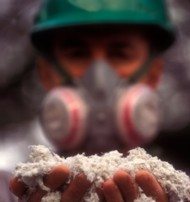New Lung Cancer Screening Guidelines Could Catch Some Mesotheliomas Earlier
 New lung cancer screening guidelines for smokers might have an unexpected benefit for people who have also been exposed to asbestos: They may catch mesothelioma earlier.
New lung cancer screening guidelines for smokers might have an unexpected benefit for people who have also been exposed to asbestos: They may catch mesothelioma earlier.
Malignant pleural mesothelioma is a lung-related cancer caused by asbestos. It develops over many years. Many mesothelioma patients do not show any symptoms until the disease is very advanced. There is currently no routine screening for mesothelioma.
The new lung cancer screening guidelines apply to people ages 50 to 80. They suggest that those who have smoked the equivalent of a pack a day for 20 years should have annual low-dose CT scans.
If screening shows a tumor, doctors can dig further to determine its type. Both lung cancer and pleural mesothelioma are more responsive to treatment before they have spread.
Understanding the New Lung Cancer Screening Guidelines
Lung cancer is the most common type of cancer in the US. Smoking is the biggest risk factor for lung cancer. In 2019, the National Lung Screening Trial concluded that low-dose CT scans of high risk patients reduced the risk of lung cancer by 20 percent.
The new lung cancer screening guidelines come from the US Preventive Services Task Force. They apply to smokers between 50 and 80.
The guidelines recommend a yearly low-dose CT scan for heavy smokers. A heavy smoker is anyone who has smoked the equivalent of a pack a day for 20 years. This could include people who smoked two packs a day for 10 years, or those who smoked less, but did so over a longer period of time. It also includes people who have quit within the past 15 years.
Malignant mesothelioma is most common in people who lived or worked around asbestos. Asbestos is the primary risk factor for mesothelioma. But studies show that asbestos workers who also smoke have an even higher risk for mesothelioma.
By screening older smokers, the new lung cancer screening guidelines could help doctors identify and treat mesothelioma tumors they might otherwise miss.
Low-Dose CT Scans and Mesothelioma
Malignant pleural mesothelioma is the most deadly disease caused by asbestos. Mesothelioma tumors grow on the lining around the lungs. Over time, they restrict the lungs’ ability to expand. The disease is usually fatal within a year.
Germany has been covering low-dose CT screening for asbestos workers at risk of mesothelioma since 2016. A pair of radiology researchers summed up the decision in an article in the journal Radiologe.
But not everyone agrees with the new lung cancer screening guidelines. Critics say LDCT for mesothelioma and lung cancer can lead to unnecessary radiation exposure, false positive results, overtreatment, and unneeded surgeries.
An estimated 2,500 Americans receive a mesothelioma diagnosis each year. Most have Stage III or IV cancer by the time they are diagnosed.
Source:
Lung Cancer: Screening, Final Recommendation Statement, March 9, 2021, US PReventive Services Task Force, https://www.uspreventiveservicestaskforce.org/uspstf/recommendation/lung-cancer-screening





